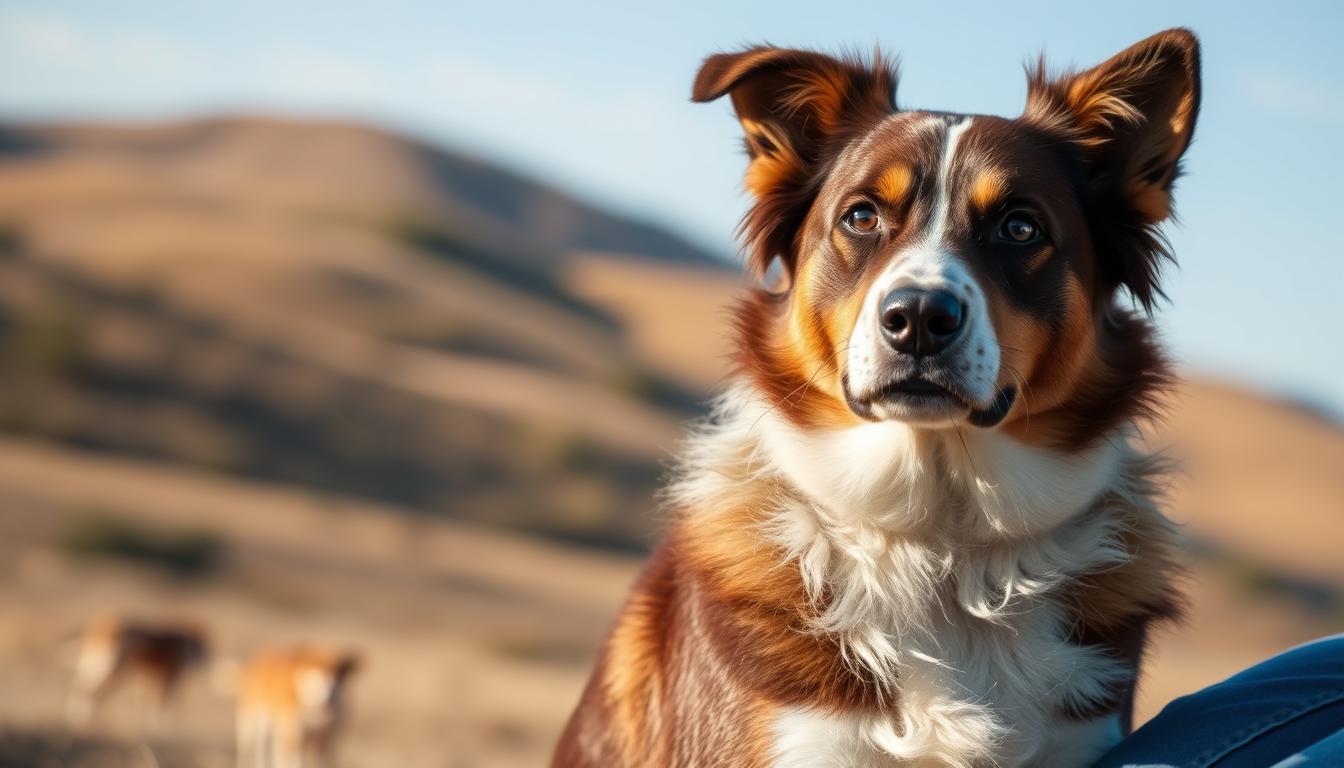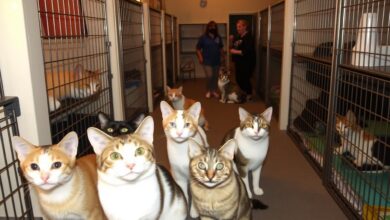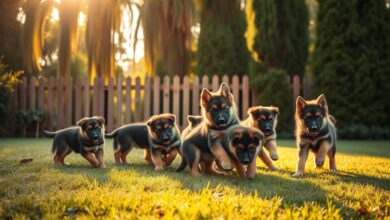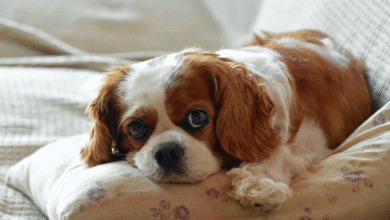The Australian Cattle Dog: Your Loyal Companion
Are you an active owner looking for a loyal companion? If so, the Australian Cattle Dog might be perfect for you. This breed is known for its smarts, energy, and love for its family.

They have a strong build and are very agile. This makes them great for people who love being outdoors. Their loyalty and protective nature make them excellent family pets. Plus, their intelligence means they’re easy to train.
Key Takeaways
- You can expect a high level of loyalty from this breed.
- They require regular exercise to stay happy and healthy.
- Their intelligence makes training relatively straightforward.
- They are generally great with families.
- Regular grooming is necessary to keep their coat in good condition.
Origins and History of the Australian Cattle Dog
The Australian Cattle Dog has a long history, starting in the early 19th century. Australia’s cattle industry was booming back then. There was a need for a strong dog that could handle the tough Australian outback.
Development in Australia’s Harsh Conditions
The breed was made to handle Australia’s tough terrain. This includes extreme temperatures, vast distances, and challenging terrain. Resilience and endurance were key traits bred into the Australian Cattle Dog. It became a valuable asset to cattle farmers.
The breed’s ability to work hard in tough conditions made it perfect for herding.
Dingo Crossbreeding and Modern Breed Establishment
The Australian Cattle Dog was developed by crossbreeding with native dingos. This created a dog that was not only strong but also smart and agile for herding cattle. This crossbreeding was key in making the modern Australian Cattle Dog.
Today, the breed is known for its versatility and effectiveness in herding and other jobs.
Physical Characteristics of the Blue Heeler
The Blue Heeler was bred for herding cattle. It has a strong build and distinctive coat. This makes it a great pet for those who love to stay active. Adorable French Bulldog Puppies for Sale
Size, Weight, and Build
The Blue Heeler is medium-sized and muscular. It weighs 30-50 pounds and is 17-22 inches tall. Its athletic physique is perfect for working hard.
Coat Colors and Patterns
The Blue Heeler’s coat is known for its blue or red speckled patterns. The blue coat can be light or dark, with black or tan spots. The red variety has similar patterns in red shades.
Distinctive Physical Features
The Blue Heeler has pricked ears and a robust bone structure. Its dark, alert eyes show its intelligence and energy. The Blue Heeler’s looks match its smart and active nature.
The Australian Cattle Dog’s Temperament and Personality
The Australian Cattle Dog is known for its loyalty, intelligence, and energy. It’s more than just a pet; it’s a family member. This dog has a strong work ethic and is very loyal, making it great for work and as a loving companion.
Loyalty and Protective Nature
The Australian Cattle Dog is fiercely loyal to its family. It’s naturally protective, making it a good watchdog. It’s also very affectionate, showing a deep bond with its family. Their loyalty is one of their most cherished traits, as they stand by their owners through thick and thin.
Intelligence and Problem-Solving Abilities
This breed is highly intelligent and can solve problems on its own. Australian Cattle Dogs are resourceful and can often find solutions to challenges. Their intelligence makes them highly trainable, and they excel in dog sports and activities that challenge their minds.
| Trait | Description |
|---|---|
| Loyalty | Unwavering dedication to family |
| Intelligence | Highly intelligent and trainable |
| Protective Nature | Instinctively protective of family and territory |
Social Behavior with Family and Strangers
Australian Cattle Dogs are reserved with strangers but warm up quickly. They form strong bonds with their family and are often called “velcro dogs” because they stick close. While they can be cautious around new people, early socialization helps them become confident and friendly.
In summary, the Australian Cattle Dog’s temperament is a perfect blend of loyalty, intelligence, and protective nature. It’s an ideal companion for active families or individuals who can provide the necessary care and attention.
Training Your Australian Cattle Dog
Effective training is key to a happy and healthy relationship with your Australian Cattle Dog. They are smart and loyal, needing both mental and physical challenges. A structured training program is essential for them.
Early Socialization Importance
Early socialization is vital for Australian Cattle Dogs. It exposes them to different environments, people, and animals. This helps prevent behavioral issues and makes them confident and well-adjusted. Socialization should start early, ideally from 8 weeks old, and continue during important developmental periods.
Effective Training Methods for This Intelligent Breed
Australian Cattle Dogs are very intelligent and do well with positive reinforcement training. Consistency and patience are key, as they can be strong-willed. Adding variety to training, like agility and obedience exercises, keeps them engaged and stimulated. “The right training method can make all the difference in developing a well-behaved and happy dog,” say dog training experts.
“Positive reinforcement is not just a method, it’s a way of communicating with your dog that fosters trust and understanding.”
Addressing Common Behavioral Challenges
Australian Cattle Dogs often face challenges like herding behavior, high energy, and stubbornness. Redirecting herding instincts into appropriate activities and ensuring enough physical and mental exercise can help. Consistent training and clear boundaries manage their energy and assertiveness.

Understanding and addressing your Australian Cattle Dog’s unique needs helps create a training plan. This plan not only corrects behavioral challenges but also strengthens your bond with your dog.
Exercise Needs of This Energetic Working Dog
Australian Cattle Dogs need lots of physical and mental play to stay happy. They were bred to herd cattle, so they have lots of energy. This energy must be used through regular exercise.
Daily Physical Activity Requirements
These dogs need 1-2 hours of activity every day. This can be walks, runs, and playtime. They also love having a big, fenced yard to run around in.
- Morning and evening walks
- Playtime in a securely fenced yard
- Running or jogging companions
- Engaging in dog sports like agility or obedience training
Mental Stimulation and Enrichment
Mental play is as important as physical for Australian Cattle Dogs. They are very smart and need challenges for their minds.
Here are some ways to keep their minds sharp:
- Interactive puzzle toys
- Scent work or tracking exercises
- Learning new commands or tricks
- Problem-solving games
Activities and Sports for Australian Cattle Dogs
Australian Cattle Dogs do well in many dog sports and activities. They use their brains and bodies in these activities.
Some favorite activities include:
- Agility training
- Obedience competitions
- Herding trials (if they have been trained for herding)
- Canine freestyle or dancing with your dog
Combining physical and mental activities keeps your Australian Cattle Dog happy and healthy.
Health Considerations for Your Blue Heeler
As a responsible Blue Heeler owner, knowing about health issues is key. Blue Heelers are generally healthy but can face some problems. These need attention and care.
Common Genetic Health Issues
Blue Heelers might have deafness and blindness. Early detection through hearing and vision tests is important. They can also get hip dysplasia and elbow dysplasia, so watching their joints is vital.
| Health Issue | Description | Preventative Measure |
|---|---|---|
| Deafness | Partial or complete hearing loss | Regular hearing tests |
| Blindness | Partial or complete vision loss | Regular eye exams |
| Hip Dysplasia | Malformation of the hip joint | Monitor joint health, maintain healthy weight |
Preventative Care and Regular Checkups
Preventative care is essential for your Blue Heeler’s health. Regular vet visits can spot problems early. This includes keeping up with vaccinations, parasite control, and dental care.
Nutrition and Diet Requirements
A balanced diet is key for your Blue Heeler’s health. Choose high-quality dog food with protein and moderate fat. Avoid overfeeding to prevent obesity.

Understanding these health considerations and acting early can ensure your Blue Heeler’s long, happy life.
Grooming Your Australian Cattle Dog
To keep your Australian Cattle Dog healthy and happy, regular grooming is key. This breed has a unique coat that needs special care. This care helps keep it healthy and looking good.
Coat Maintenance and Shedding Management
The Australian Cattle Dog’s coat protects it from harsh weather. Regular brushing is important to remove dirt and keep the coat healthy. Brush your dog at least once a week, more often during shedding season. Use a brush made for their coat type to avoid irritation.
- Use a slicker brush or a pin brush for regular grooming.
- Increase brushing frequency during shedding season.
- Check for mats and tangles, behind the ears and under the collar.
Bathing, Nail Care, and Dental Hygiene
Bathing should be done as needed, usually every few months. Unless your dog gets dirty or smells strongly. Regular nail care is also important; trim your dog’s nails every few weeks to prevent overgrowth. Dental hygiene is key for your dog’s health; brush their teeth regularly to prevent tartar buildup and keep their breath fresh.
Living with an Australian Cattle Dog as Your Loyal Companion
To live well with an Australian Cattle Dog, you must know their needs. They love to be active and need lots of interaction. They don’t do well if they’re alone for too long or if they’re not moving much.
Home Environment Considerations
An Australian Cattle Dog needs room to run around. A house with a yard is best. But, they also need mental challenges. Give them puzzle toys and activities that use their herding skills.
Compatibility with Children and Other Pets
Australian Cattle Dogs are great with kids if they’re socialized early. But, they might try to herd them or other pets. Teach them not to do this and watch them when they’re with young kids.
Urban vs. Rural Living with a Herding Breed
Australian Cattle Dogs do well in many places, but they love to move. Rural areas are best, but they can also be happy in cities if they get enough exercise and mental play.
| Living Situation | Ideal Conditions | Challenges |
|---|---|---|
| Rural | Ample space for exercise, opportunities for herding | Potential isolation, need for secure fencing |
| Urban | Regular exercise routine, mental stimulation | Limited space, possible noise issues |
Knowing these things helps you give your Australian Cattle Dog a great life. They’ll be happy and loyal to you.
Is the Australian Cattle Dog Right for Your Lifestyle?
Before getting an Australian Cattle Dog, think if your lifestyle fits theirs. Owning a pet is a big decision. It’s important to see if your life and the dog’s needs match well.
Ideal Owner Characteristics for This Working Dog
The Australian Cattle Dog isn’t for everyone. Ideal owners are active and enjoy the outdoors. They also like to keep their dogs busy with physical and mental games. If you or your family loves loyalty and wants a pet to spend time with, this breed could be perfect.
Dog trainers say, “The Australian Cattle Dog does best with an experienced owner.” They need someone who sets clear rules and keeps them mentally sharp.
| Owner Characteristic | Ideal Trait |
|---|---|
| Activity Level | High |
| Training Experience | Intermediate to Advanced |
| Time Commitment | High |
Lifestyle Compatibility Assessment
Think about your home and daily life to see if an Australian Cattle Dog fits. Do you have enough space for your dog to run around? They need lots of exercise to be happy.
“Australian Cattle Dogs are very energetic. They need owners who can keep up. Without enough exercise, they might get destructive or restless.”
Look at your work schedule, how often you travel, and if you can train and socialize your dog regularly. If you’re away a lot, you’ll need someone to take care of your dog or make sure they get enough exercise and mental play.
By thinking about your lifestyle and what the Australian Cattle Dog needs, you can decide if they’re the right pet for you.
Finding and Adopting Your Australian Cattle Dog
Ready to welcome an Australian Cattle Dog into your home? It’s important to know your adoption choices. This breed is loyal and smart, perfect for active families or individuals.
Reputable Breeders vs. Rescue Organizations
Choosing between a breeder and a rescue depends on what you want. Reputable breeders offer health checks for the puppy’s parents and might have a waitlist. Rescue organizations give a loving home to dogs in need.
- Reputable Breeders:
- Provide health clearances for parents
- Often have a waitlist for puppies
- Can offer guidance on breed-specific traits
- Rescue Organizations:
- Offer adult dogs or puppies for adoption
- Help with the rehabilitation of dogs
- Provide a second chance for dogs in need
What to Look for in a Healthy Puppy or Adult Dog
Adopting a puppy or adult dog? Look for certain health and behavior signs. A healthy Australian Cattle Dog has clear eyes, a shiny coat, and lots of energy but not too much aggression or fear.
Key Health Indicators:
- Clear eyes and ears
- A shiny, well-maintained coat
- Active and responsive to surroundings
By thinking carefully about your options and what to look for, you can have a happy and healthy bond with your new Australian Cattle Dog.
Conclusion: The Rewarding Journey with Your Australian Cattle Dog
The Australian Cattle Dog is more than a pet. They are a loyal companion, known for their intelligence, energy, and protective nature. Owning one can be a rewarding journey, filled with joy, companionship, and adventure.
Understanding their origins, physical traits, temperament, and needs is key. This knowledge helps you care for your Australian Cattle Dog. Whether you’re new to dog ownership or experienced, this breed will captivate and enrich your life.
As you journey with your Australian Cattle Dog, you’ll find their loyalty and affection priceless. With proper training, exercise, and love, they will be your loyal companion. They will stand by your side through life’s ups and downs.
FAQ
What is the average lifespan of an Australian Cattle Dog?
Australian Cattle Dogs live about 12-15 years. This depends on their diet, exercise, and health.
Are Australian Cattle Dogs good with children?
Yes, they can be great with kids if they’re socialized early. Always watch when kids and dogs play together.
Do Australian Cattle Dogs shed a lot?
They have a short coat that sheds a bit. Brushing them often helps keep their coat in good shape.
Are Australian Cattle Dogs easy to train?
Yes, they’re smart and easy to train. They do well with positive training and consistency.
Can Australian Cattle Dogs thrive in apartment living?
They can live in apartments but need lots of exercise and mental play. They’re best in homes with yards or with active owners.
What are common health issues in Australian Cattle Dogs?
They can get deafness, blindness, and hip dysplasia. Regular vet visits and genetic tests can catch these early.
How much exercise does an Australian Cattle Dog need?
They need lots of exercise to be happy and healthy. At least 30 minutes of playtime each day is a must.
Can Australian Cattle Dogs be used as working dogs?
Yes, they’re great at herding on farms and ranches. They have a strong work ethic and are often used for this.




